Stormgate is shaping up to be a brilliant blend of modern and classic RTS
Hands-on with Frost Giant's ambitious StarCraft 2 successor.
Stepping into a Stormgate match is like entering a portal back to the halcyon days of Warcraft, Starcraft and Command & Conquer, back when the RTS masters of the time, Blizzard and Westwood, were continually trying to one-up each other. Developer Frost Giant was formed by Blizzard veterans, so this is not accidental. Yet this does not feel like a throwback exclusively dealing in nostalgia. It's built on familiar foundations, but there's progression here, with new ideas and interesting twists sitting alongside classic touches.
In my first match, playing as some mech-loving humans known as the Vanguard, I begin with an HQ, an adorable robo-dog—my scout—and some robotic workers chipping away at a resource node. It's one of two main resources in the game, the second being something akin to tiberium from C&C. Initially it's a small patch of crystals, but left alone it starts to spread, and leaving it for a time enriches the crystals. This gives me my first strategic conundrum: do I go full hog and start gobbling up all these starting resource nods, or do I take things slow and wait for a larger payout later?
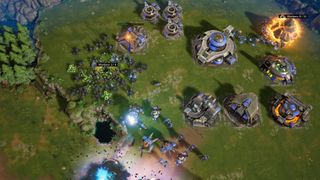
"It introduces some interesting decisions in where to harvest and which patches are worth more at different points in time," says game director Tim Campbell as I'm pondering my next move. "And this resource also shows up in different states during the game. This first one, for example, is already spreading. There are other ones that are veins underneath the ground that you kind of have to find and smash open."
I'm greedy and impatient, it turns out, so I build some more workers and they start going to town on the crystals. As I play around with my base and start constructing new buildings and bringing in more units, I'm struck by how good it all feels to control. Instead of trying to remember a long list of hotkeys, I've got "quick macros" that are displayed on the UI—so I never forget—that bring up all the construction and recruitment menus. So I hit Q to bring up my construction list, then S to select a supply-generating building, which I then plonk down.
So I can get on with more important business, I don't need to command workers to construct this building. That's automated. One of the workers mining resources stops what they're doing, saunters over to the blueprint and gets to work. Once it's done, it heads back to the node, but because it's a little efficient robot, it first deposits some resources it's carrying in the HQ.
"We have a lot of factors which go into determining which worker to pull," says Campbell, "depending on whether they're on kind of an auto repetitive order, whether you've told them to do something specific, how far away they are, yada yada, and this allows you to not have to hunt and find the person and then go into some some subfolder—you can just drop a building down."
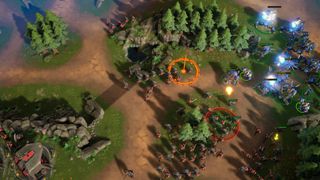
If you prefer the more tactile way of doing things, where you select a specific worker and choose the building from their menu, which they'll then immediately start constructing, you can still do that. Taking advantage of the macros and automation, though, feels like the way to go, and the presentation of the UI means that even RTS novices should have a frictionless experience as they expand their base, recruit new troops and research upgrades just by hitting a couple of keys regardless of what part of the map they are focusing on.
The biggest gaming news, reviews and hardware deals
Keep up to date with the most important stories and the best deals, as picked by the PC Gamer team.
Though it's not in the build I'm playing, automatic control groups will also feature, so when you recruit units they are put in control groups with units of the same type. Of course, you'll be able to assign them yourself, as well, creating your own specialised squads.
With my robots diligently working away, it's time to explore the battlefield with my trusty hound. This scout unit is unique to the Vanguard faction, and it has handy sensors that highlight units beyond its range with an exclamation mark. So you know there are some dangers out there, but not the specifics of those dangers. Thankfully my scout has an ability (with a cooldown) that temporarily expands its range, potentially letting you see these impending dangers with full clarity.
My robo-pup quickly finds something interesting: a creep camp. The concept should be familiar to Warcraft 3 players, and of course anyone who has played one of the many MOBAs that initially spawned from the game's modding community before becoming their own distinct genre. But here they work a bit differently.
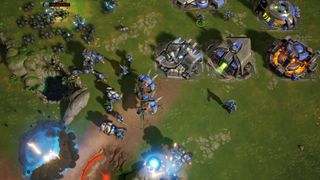
"We're experimenting with creep camps a lot because we don't want to just do what MOBAs do or Warcraft 3 did," says Campbell. "Warcraft 3 was really the first introduction of creep camps to the RTS genre. And I love it for what it was. And I'm proud of having worked on it. But it did bring with it some rough edges. Once you cleared the camps, they were gone. So they became only a temporary factor in gameplay; they also had a lot of RNG elements in terms of drops from them. So we're trying to adapt the concept of creeps to get players out onto the map to spar in the middle, rather than the early game coming down to cheeses on main bases—like can you quickly KO and force somebody to surrender early. We want to get people sparring out in the middle of the map and get them fighting over these things."
The presentation of the UI means that even RTS novices should have a frictionless experience as they expand their base, recruit new troops and research upgrades.
They certainly seem worth fighting over. One camp I find generates a handy healing buff upon defeating the creep. Even more helpful are the camps I find at either side of the map, which give me a full view of the surrounding area. With both of them active, and a scout left in the middle of the map, all the routes to my base are covered, giving me absolutely vital information about enemy movements. Because the effects are residual, they remain relevant throughout the game. And some of them can benefit both sides. If you clear a camp and get a speed boost, your opponent can then visit and get that same boost, potentially inspiring you to leave some troops behind to protect it. Creeps respawn, too, and they come back tougher.
Another way Frost Giant intends to get players fighting in the middle of the map and brawling over territory is by making it harder to assault bases, at least in the earlier game. My base, and the base of my opponent, is entered through a chokepoint that's easily defendable with a few turrets, and my little robotic workers can serve as mechanics, repairing my mechanised or cybernetic units. So defenders have an advantage, making an early base rush a risky move.
This map I'm playing in is a verdant, heavily-forested location where the terrain creates a network of paths through the battlefield, but you don't need to follow this path. The forests are all fully destructible, allowing you to create convenient shortcuts and set up sneaky attacks. There are light forests, too, which allow units to pass through them, and while inside they're concealed. It's a good place to hide a scout, letting them keep an eye on the area from the safety of the trees.
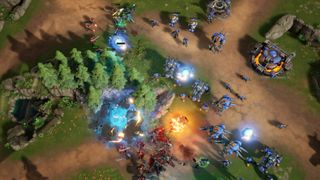
"We want our battlefields to update as you go through fights," says Campbell. "We want the landscape to kind of be changing. And so this is just the first step in that direction. We have a bunch of things planned on the terrain side. Maybe it says something about me, I don't know, but it is strangely satisfying to just deforest everything."
Vulcans, a type of assault mech, have a rather unique way of traversing the map, as they can get access to jump jets that allow them to simply smash through heavily-forested areas, demolishing the trees in the process, or jump over cliffs. They're great for murdering crowds of enemies, as they wield massive chain guns where the rate of fire increases the longer they're firing. But you need to think about their positioning to take advantage of this, and also think about how you'll reposition them.
"Their chain guns punch through enemies in a straight line," Campbell explains. "So positioning them to be able to hit as many targets as possible is useful. But when you stop attacking a target to walk into a different place, the chain gun spins down and you lose that boost to its rate of fire. So what the jump jets do is it allows you to reposition without losing your spin. Of course using that has a cooldown so you can no longer use it to escape or to chase people down. So you know there's always always tactical choices to make."
They seem badass, so naturally I build a bunch of them as soon as I can.
Joining my squad of Vulcans is a Hedgehog—a type of missile-wielding jeep. It's a fast vehicle with an explosive payload. It can fire off its missiles rapidly, doing a lot of damage, but then it has to reload. So its effectiveness is balanced out by micromanagement requirements, as it needs to dart in and out of combat so it can load up new missiles. The payload is visible on the vehicle, which means both you and your opponent can tell when it's vulnerable and must peace out to reload.

Every time I'm introduced to a new unit, I find myself uttering "That's so cool". They all fit into familiar RTS roles, but there's almost always a quirk that sets them apart. Take the Atlas, for example. It's a massive, gorilla-like mech that transforms into a static artillery unit, a lot like Starcraft's Siege Tank. But what it fires is a ball of electricity, which can be upgraded so that its effect remains on the ground, effectively letting you create obstacles and giving you more control over the battlefield. It also deals friendly fire damage, so you'll need to be wary.
Every time I'm introduced to a new unit, I find myself uttering "That's so cool".
Expect to field medics, troops with sticky bombs, stealth units and units that can even burrow underground. There are also several flying units, though Frost Giant is wary of making them too prevalent, given the importance of terrain—which flying units can naturally ignore. The first flying unit I produce is more of a support unit, as its function is to transport troops. I also unlock a devastating aerial bomber, which is balanced out by how incredibly slow it is. That can be somewhat negated through upgrades, but not to the point that it ceases to have any vulnerabilities. That didn't stop me making a whole bunch of them and raining hell down on my opponent's base. Extremely satisfying.
I find myself feeling very much at home in Stormgate, even as I'm discovering novelties. It's in an early alpha state at the moment where there are still plenty of features yet to come, but crucially it's already a lot of fun to play. And this is just in the multiplayer skirmishes; there's also going to be campaigns that spin a tale over multiple years.
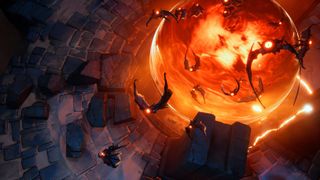
"We worked really hard with some talented writers to plot out some multi-year marks for our backrow storytelling," says Campbell. "And what that does is it lets us build campaigns, knowing where certain characters' storylines are going to get to and what conflicts are over the horizon, so we can set the stage for them really well. We will be releasing campaigns every single year, with the campaigns broken up into episodic formats. So players can play episodes of levels that are kind of like map packs as they become available, or players can wait until an entire chapter is complete and then play through all of it all in one fell swoop."
These seasonal campaigns will also be playable both in singleplayer and in co-op, which makes sense for a game that's being designed to be a social experience. This is emphasised by things like objective-based battles, which will encourage communication between players.
On the competitive side of things, meanwhile, Frost Giant plans to integrate esports into the game client and hopes to make it more accessible for all players to participate in, regardless of skill level. Map editing tools will also be integrated into the client, "so you can build a level and press a button and immediately be flipped into playing that level," says Campbell.
While Stormgate doesn't have a release date yet, closed external testing begins in July. You can sign up on the official site for a chance to play early.

Fraser is the UK online editor and has actually met The Internet in person. With over a decade of experience, he's been around the block a few times, serving as a freelancer, news editor and prolific reviewer. Strategy games have been a 30-year-long obsession, from tiny RTSs to sprawling political sims, and he never turns down the chance to rave about Total War or Crusader Kings. He's also been known to set up shop in the latest MMO and likes to wind down with an endlessly deep, systemic RPG. These days, when he's not editing, he can usually be found writing features that are 1,000 words too long or talking about his dog.
Most Popular


